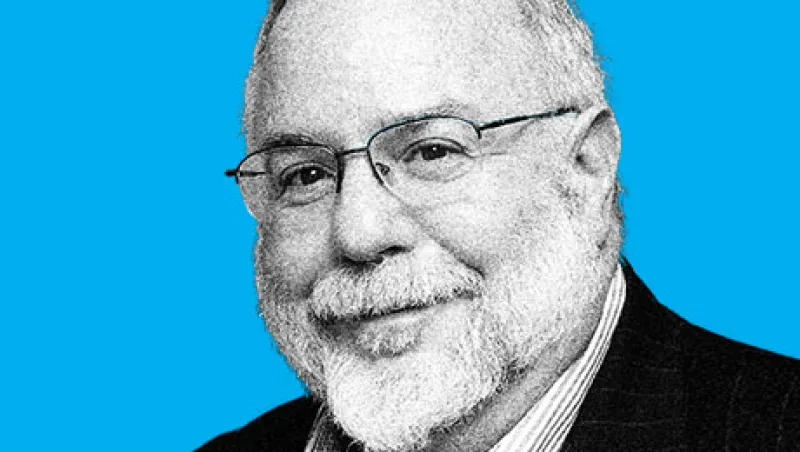After almost 40 years in the financial industry, Jon Lukomnik sees plenty of room for improvement. The pension and asset management governance veteran lays out his prescriptions in his latest book, What They Do With Your Money: How the Financial System Fails Us and How to Fix It.
Lukomnik, 60, is managing partner of Sinclair Capital, a consulting firm whose clients include asset managers and owners. Since 2008 the New York native has been executive director of the Investor Responsibility Research Center Institute, which examines corporate governance and capital markets issues. Lukomnik began his career in civic roles that included deputy comptroller of and investment adviser to the New York City Pension Funds during the 1990s. He’s also directed public and private companies, not-for-profits, and litigation trusts, and served on the creditors committee that rehabilitated bankrupt telecommunications giant WorldCom. A trustee for mutual fund firm VanEck, he co-founded the International Corporate Governance Network in 1995.
Lukomnik’s new book, written with Stephen Davis, associate director of the Harvard Law School Programs on Corporate Governance and Institutional Investors, and David Pitt-Watson, executive fellow of finance at London Business School, proposes overhauling an inefficient financial system focused on short-term performance.
Why did you write this book?
About five or six years ago my co-authors and I were having a drink post–financial crisis, when the central banks were flooding the world with liquidity. It was clear that the banks were dealing with the immediate crisis and the capital markets of the world were not going to implode and freeze. At the same time, we detected a certain complacency that we thought was strange because while the financial crisis was like a decapitation — that was the threat, that the markets were just going to stop — we noted that there were a lot of slow-bleed problems. They weren’t life-threatening, but they weren’t healthy for the financial market or the financial market’s clients.
What are the slow-bleed problems in the financial industry?
There are a multitude of problems that include the misuse of VaR [value at risk] models and investment consultants’ conflicts of interest. Studies have suggested that they don’t pick asset managers any better than anyone else. Another major issue has been the explosion of intermediaries in financial services. In mutual funds, for example, not only is there the management company, but then there’s a valuation agent and a proxy voting agent and an administrator in a 401(k) and a transfer agent and sometimes a subtransfer agent. If you’re using ADRs, there’s the sponsoring bank, and they’ve got three different fees. People weren’t paying attention to the slow bleed that was, in our initial opinion, making the financial sector less efficient than it could be.
What is the role of financial intermediaries today, and how has it changed?
Perhaps the most important thing the financial industry does is take money from point A in the real economy and move it to point B in the real economy, where it finances your return or new equipment or research and development. That is the real service to the economy. The question is, how much are you going to charge for the intermediation? Thomas Philippon, an economist at New York University, found that it has cost 2 percent for the past 130 years. That means that financing railroads was as efficient as financing SpaceX and Tesla. How is that possible when we have computerization, ATMs, and other technological advances?
It is true that some of the intermediate steps between the financial intermediaries have become more efficient. But we’ve offset those by increasing the complexity of the chain so there is much more of what is called the financialization of the real economy. One study found that there were 16 agents between point A and point B. While that number varies depending on a particular transaction, there has been no improvement in efficiency in the financial system in 130 years.
How has the growth of intermediaries and the inefficient movement of assets affected the industry?
We have ceased to focus on the most important element of asset management: beta, or the market. The business model of the asset management industry today relies on short-term relative performance. It also focuses heavily on trading and transaction. Everyone thinks they’re above average, like in Lake Wobegon, and that they can get short-term relative-return differential, or alpha, by trading.
But this thinking disincents us from improving the beta or efficiency of the markets. We focus on alpha and systematically have underthought what our impact could be on the beta of the marketplace. This has created a suboptimal overall market for everybody. If you’re a universal owner the way an index fund or a large pension fund is, beta is what matters.
How would you realign the financial system?
It takes a certain amount of nerve to write a book subtitled How the Financial System Fails Us, and it takes even more nerve to say, and How to Fix It. We come from the financial industry, and we don’t want to blow up the system. No one wants to put asset managers out of business, and most asset managers do a good job. But we need to decrease the amount of complexity, reduce the number of agents, and pay attention to the marketplace as a whole, not just try to trade our way to relative return.
In our book we recommend close to 100 individual, specific suggestions, looking at new technologies, suggesting different ways to regulate that can improve the efficiency of the system and better align it with the needs of the real economy and society as a whole. Some of them are quite technical; others are quite general, such as extending fiduciary obligation through the chain of intermediaries to anyone who’s managing other people’s money.
In another example of positive change, the Canadian pension funds are a model of the right direction in which to head. The pension fund officials cut out a number of intermediaries by investing directly, they have longer time horizons, and their returns are better on average than at U.S. pension funds.






